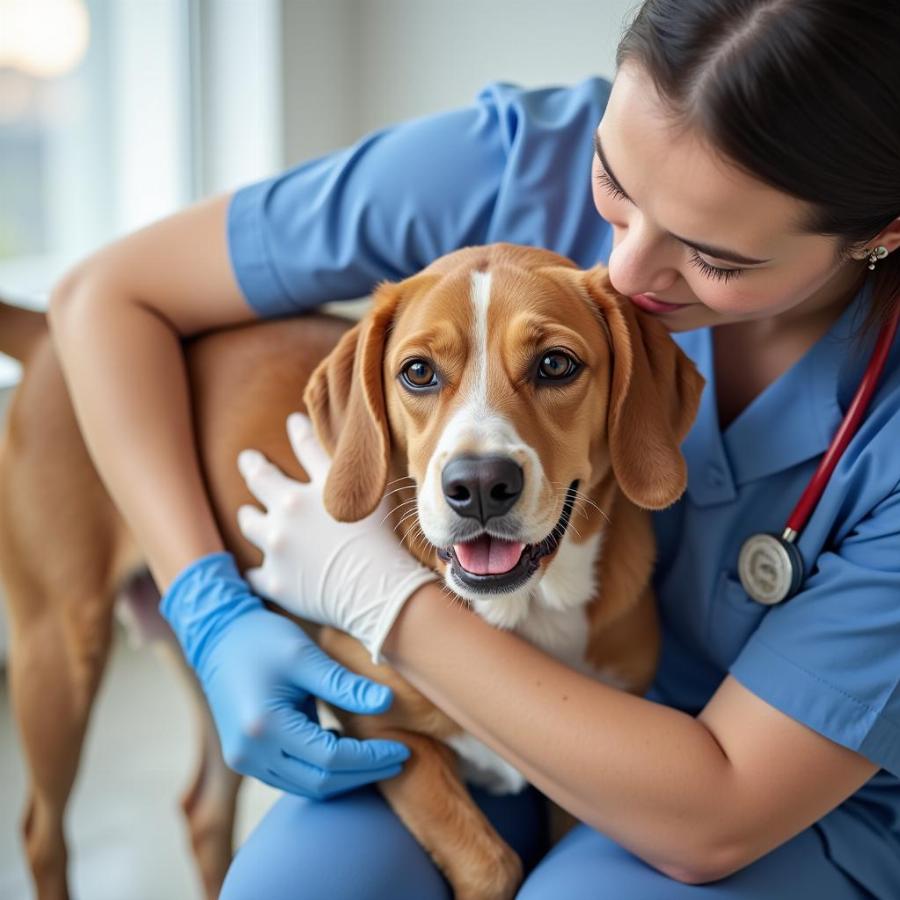Dog bed sores, also known as pressure sores or decubitus ulcers, are a serious health concern for our canine companions. These painful wounds develop when prolonged pressure cuts off circulation to the skin and underlying tissues. If you’re worried about dog bed sores, this comprehensive guide will provide you with the essential information you need to understand, prevent, and address this often debilitating condition.
What Causes Dog Bed Sores?
Pressure sores in dogs typically occur in areas where bones are close to the skin and lack adequate padding, such as the elbows, hips, hocks, and tailbone. Immobility is the primary risk factor. Dogs who are unable to shift their weight regularly, due to old age, illness, paralysis, or obesity, are particularly susceptible. Other contributing factors include poor nutrition, inadequate hygiene, and underlying medical conditions that compromise circulation.
Recognizing the Signs of Dog Bed Sores
Early detection is crucial in treating dog bed sores. Initially, the affected area may appear reddened, discolored, or swollen. As the sore progresses, the skin may break down, forming open wounds that can become infected. In severe cases, the sores can extend deep into the muscle and bone, causing significant pain and discomfort. If you notice any of these signs, consult your veterinarian immediately.
Preventing Dog Bed Sores: Proactive Care is Key
Preventing bed sores is far easier than treating them. Providing your dog with a comfortable, supportive bed is essential. Look for beds made of high-quality, pressure-relieving materials like memory foam or orthopedic foam. Ensure the bed is clean and dry, and change the bedding regularly.
 Caring for a Dog with Bed Sores
Caring for a Dog with Bed Sores
Treating Dog Bed Sores: A Multifaceted Approach
Treatment for dog bed sores depends on the severity of the wound. Mild sores may only require regular cleaning and the use of protective bandages. More severe sores may necessitate debridement (removal of dead tissue), antibiotics to combat infection, and pain management medication. In some cases, surgery may be necessary to repair extensive tissue damage.
How to Clean a Dog Bed Sore
Cleaning the sore is a vital part of the treatment process. Your veterinarian will guide you on the appropriate cleaning solution and technique. Typically, this involves gently washing the area with a mild antiseptic solution and patting it dry with a sterile gauze pad.
Providing Comfort and Support for Your Dog
During the healing process, it’s essential to provide your dog with a comfortable and stress-free environment. Ensure they have a soft, supportive bed in a quiet area of the house. Regularly reposition your dog to relieve pressure on the affected areas. If your dog is immobile, consider using a lifting sling to help them change positions.
Nutrition Plays a Vital Role
Proper nutrition is crucial for wound healing. Ensure your dog is receiving a balanced diet rich in protein, vitamins, and minerals. Your veterinarian may recommend adding supplements to support skin health and boost the immune system.
When to Seek Veterinary Care
If you suspect your dog has a bed sore, don’t delay seeking veterinary care. Early intervention is key to preventing complications and promoting healing.
Conclusion
Dog bed sores are a preventable condition. By understanding the risk factors and taking proactive measures, you can help your furry friend avoid this painful and debilitating problem. Remember, providing a comfortable bed, regular repositioning, proper nutrition, and prompt veterinary care are essential for preventing and managing dog bed sores.
FAQ
- What are the first signs of a bed sore in a dog? Look for redness, discoloration, swelling, or hair loss in areas where bones are prominent.
- How often should I change my dog’s bedding? At least weekly, and more frequently if soiled.
- Can I treat my dog’s bed sore at home? Always consult with your veterinarian before attempting any home treatment.
- What kind of bed is best for a dog prone to bed sores? Orthopedic or memory foam beds provide excellent pressure relief.
- How can I help my immobile dog avoid bed sores? Regular repositioning and the use of a lifting sling can help distribute pressure.
- What should I feed my dog with bed sores? A balanced diet rich in protein and essential nutrients is crucial.
- How long does it take for a dog bed sore to heal? Healing time varies depending on the severity of the sore, but it can take several weeks or even months.
Further Reading
For more information on dog skin health, you may find these articles helpful:
Beaut Dogs is your trusted source for all things dog-related. We provide expert advice, valuable insights, and comprehensive resources to help you care for your canine companion. From breed information to health and nutrition tips, Beaut Dogs is your one-stop shop for all your dog care needs. Visit us at https://beautdogs.com. When needing assistance with your dog’s health or any related concerns, contact us via Email at [email protected] for detailed and accurate guidance from Beaut Dogs.